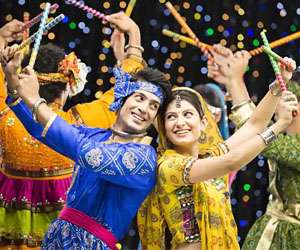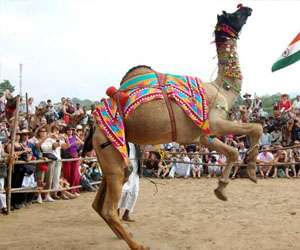The spirit of India is expressed year-round in festivals as diverse as the country's landscapes and as lively as its people. Enthusiastic celebrations of gods and goddesses, saints and prophets, history, culture and the advent of new seasons occur almost daily throughout the country. By taking part in these colorful festivities, you will see the vitality of India today as it embraces the traditions of its fascinating past. Click here for a full listing and description of India's many brilliant festivals.
 Navatari is the longest Hindu festival, lasting nine consecutive nights. It is celebrated throughout India, and the first nine days honor the goddess Durga while the tenth day pays tribute to the spiritual hero Lord Rama. He is the hero of the epic Ramayana and a man who upholds loyalty, honesty and love. The epic is an important part of the Hindu canon and is an integral part of several Indian festivals.
Navatari is the longest Hindu festival, lasting nine consecutive nights. It is celebrated throughout India, and the first nine days honor the goddess Durga while the tenth day pays tribute to the spiritual hero Lord Rama. He is the hero of the epic Ramayana and a man who upholds loyalty, honesty and love. The epic is an important part of the Hindu canon and is an integral part of several Indian festivals.
To take part in some of the most joyous Navatari celebrations, head to Gujarat, Palakkad, Tamil Nadu or Bengal. In Gujarat, people gather nightly to watch beautiful dance tributes to Lord Rama. In Palakkad, you'll witness a herd of elegantly adorned elephants. While many festivals feature elephants, at this small village, the herd tops out at 15 -- making it ones of the biggest in India.
This festival is a social and theatrical event, celebrated throughout India with drama, dance and cultural performances, usually in late September or early October each year.

This is five-day festival representing the start of the Hindu New Year, it also honors the moral victories of good over evil. Specifically, Lord Rama and his wife Sita's return to their kingdom after defeating an ominous and evil demon. The festivities are dependent on the lunar cycle, but they usually take place between October and November.
The main event of this festival occurs on the third day. Clay lamps called "diyas" are lit, signifying the victory of good over evil within the individual. The widespread glow of diyas gives the festival its nickname, the "Festival of Lights." The fourth day is New Year's Day and is culturally regarded as the most auspicious day to begin any new endeavor.
To experience a truly beautiful Diwali celebration, head to the "pink city" of Jaipur. Each year the town holds a competition for the most brilliantly lit market.

This festival pays respect to the beloved Lord Ganesha, the elephant-headed god of all good beginnings and success. A large number of idols, made of clay or metal in varying shapes and sizes, are worshipped for 10 days within houses and businesses. On the tenth day, the idol is ceremoniously removed and carried in a procession through the streets. An amazing place to witness the Ganesh Chaturthi is Mumbai -- where people flock to the sea on the tenth day to submerge their idols.
Maharashtra also has a festival that includes traditional dancing, musical performances, poetry recitations and theatrical performances. Here, the festival lasts 10 days, and the procession is a joyous and widely attended event.
Ganesh Chaturthi is usually celebrated in August or September, once again, dependent on the lunar cycle. If you don't have 10 days to devote to Lord Ganesha, make sure you are present on the last day for the procession, celebration and feast.

This could be the liveliest of all Hindu festivals and is observed throughout North India. It marks the end of winter and the dawn of spring; it is a festival of joy and rebirth. The festival technically falls on the day following the full moon in March each year, but the celebrations always begin the night before. Crowds of people gather around bonfires, burning dry leaves and branches in a gesture symbolizing winter's end.
While Diwali is the "Festival of Lights," Holi is the "Festival of Colors." The birth of spring is marked with color, and people embrace this by dressing in vibrant clothes and throwing colored powder at each other. It truly is a unique and beautiful sight fostering a lightness of spirit and hopefulness in all who attend.
In Anandpur Sahib, Sikhs celebrate a special festival held the day after Holi called Hola Mohalla. It involves displays of ancient martial arts and mock battles commemorating the martial spirit of this ancient town.
Other notable Holi celebrations occur in Braj Bhommi, Rang Gulal, Barsana and Nandgaon.

While religion and spirituality are the basis for most festivals in India, there are some that are purely cultural. The Pushkar Camel Fair is such a festival, where 50,000 camels converge on Pushkar, located in the state of Rajasthan.
The fair originated as a business attraction, where local camel and cattle traders would convene during the holy Kartik Purnima, yet another Indian festival. The fair is now a major tourist attraction and has more to do with fun and entertainment than Kartik Purnima.
For five days, camels are dressed up, paraded, entered into beauty contests, raced and traded. A huge carnival is held that includes magicians, musicians, dancers, acrobats and snake charmers. With activities like this and camels as far as the eye can see, it truly is a one-of-a-kind experience.
The fair usually takes place in November over the course of five days. Activities start early, so be sure to come early to enjoy all the fair has to offer.